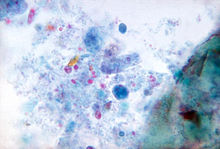Dientamoeba fragilis
| Dientamoeba fragilis | |
|---|---|

| |
| Scientific classification | |
| Domain: | |
| (unranked): | |
| Phylum: | |
| Class: | |
| Order: | |
| Family: | |
| Genus: | Dientamoeba
|
| Species: | D. fragilis
|
| Binomial name | |
| Dientamoeba fragilis Jeeps et Dobell, 1918
| |
Dientamoeba fragilis is a single-celled protist found in the gastrointestinal tract of some humans, pigs and gorillas. It causes gastrointestinal upset in some people, but not in others. [1] It is an important cause of travellers diarrhoea, chronic diarrhoea, fatigue and, in children, failure to thrive. Despite this, its role as a "commensal, pathobiont, or pathogen" is still debated.[2]
Etymology
- Di refers to the two nuclei in the trophozoites (feeding stage of the organism).
- Ent refers to the enteric environment in which the organism is found.
- The species name fragilis refers to the fact that the trophozoite stages are fragile; they do not survive long in the stool after leaving the body of the human host.
It was first described in 1918.[3]
Dientamoebiasis
Infection with D. fragilis, called dientamoebiasis, is associated variously with symptoms of abdominal pain, diarrhea, weight loss, and fever. In one study, D. fragilis was identified in 0.9% of patients observed. Its coincidence with enterobiasis has been reported.[4]
Phylogenetics
Dientamoeba fragilis is a type of trichomonad. Trichomonads are flagellated organisms but D. fragilis lacks flagella,[5] having secondarily 'lost' them over evolutionary time. Thus, it is an amoeba of flagellate ancestry. In point of ultrastructural and antigenic view, Dientamoeba is reclassified as a flagellate.
The lifecycle of this parasite has not yet been completely determined, but some assumptions have been made based on clinical data. Recently, a cyst stage has been reported,[6] although it is yet to be independently confirmed. If true, D. fragilis is probably transmitted by the fecal-oral route. Prior to the report of this cyst stage in the lifecycle of Dientamoeba, transmission was postulated to occur by helminth eggs (e.g., Ascaris, Enterobius spp.). The rationale for this suggestion was that D. fragilis is closely related to the turkey parasite Histomonas, which is known to be transmitted by the eggs of the helminth Heterakis.
Build
D. fragilis replicates by binary fission, moves by pseudopodia, and feeds by phagocytosis. The cytoplasm typically contains numerous food vacuoles that contain ingested debris, including bacteria. Waste materials are eliminated from the cell through digestive vacuoles by exocytosis. D. fragilis possesses some flagellate characteristics. In the binucleated form is a spindle structure located between the nuclei, which stems from certain polar configurations adjacent to a nucleus; these configurations appear to be homologous to hypermastigotes’ atractophores. A complex Golgi apparatus is seen; the nuclear structure of D. fragilis is more similar to that of flagellated trichomonads than to that of Entamoeba. Also notable is the presence of hydrogenosomes, which are also a characteristic of other trichomonads.[7]
See also
References
- ^ Windsor JJ, Macfarlane L (May 2005). "Irritable bowel syndrome: the need to exclude Dientamoeba fragilis". Am. J. Trop. Med. Hyg. 72 (5): 501, author reply 501–2. PMID 15891119.
- ^ Chudnovskiy, Aleksey (August 2016). "Host-Protozoan Interactions Protect from Mucosal Infections through Activation of the Inflammasome". Cell. 167 (2).
- ^ Johnson EH, Windsor JJ, Clark CG (July 2004). "Emerging from obscurity: biological, clinical, and diagnostic aspects of Dientamoeba fragilis". Clin. Microbiol. Rev. 17 (3): 553–70, table of contents. doi:10.1128/CMR.17.3.553-570.2004. PMC 452553. PMID 15258093.
- ^ Stark D, Beebe N, Marriott D, Ellis J, Harkness J (June 2005). "Prospective study of the prevalence, genotyping, and clinical relevance of Dientamoeba fragilis infections in an Australian population". J. Clin. Microbiol. 43 (6): 2718–23. doi:10.1128/JCM.43.6.2718-2723.2005. PMC 1151954. PMID 15956388.
- ^ Lagacé-Wiens PR, VanCaeseele PG, Koschik C (August 2006). "Dientamoeba fragilis: an emerging role in intestinal disease". CMAJ. 175 (5): 468–9. doi:10.1503/cmaj.060265. PMC 1550747. PMID 16940260.
- ^ Munasinghe, V. S.; Vella, N. G.; Ellis, J. T.; Windsor, P. A.; Stark, D (2013). "Cyst formation and faecal-oral transmission of Dientamoeba fragilis--the missing link in the life cycle of an emerging pathogen". International Journal for Parasitology. 43 (11): 879–83. doi:10.1016/j.ijpara.2013.06.003. PMID 23872523.
- ^ Tachezy, Jan: Hydrogenosomes and mitosomes: mitochondria of anaerobic eukaryotes ISBN 978-3-642-09542-9
External links
- ^ Ali Elbakri; Ahmed Al-Qahtani; Amidou Samie (2015). "An Overview of Tropical Diseases".
{{cite journal}}: Cite journal requires|journal=(help) - ^ Mack, David. "Dientamoeba Fragilis Infection". Emedicine Medscape. Retrieved December 9, 2016.
- ^ "Parasites - Dientamoaeba Fragilis - Biology". CDC. Retrieved December 9, 2016.
- ^ "Parasites - Dientamoeba fragilis - Treatment". CDC. Retrieved December 9, 2016.
- ^ "Dientamoeba fragilis: A harmless commensal or a mild pathogen?". Paediatr Child Health. 3. April 1998.
